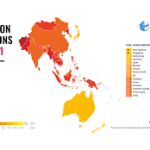
Overview of Price Trends
Global food prices experienced a slight decline in July, providing some relief amidst concerns over food security and inflation. The Food and Agriculture Organization (FAO) of the United Nations reported a modest decrease in its food price index, which tracks international prices of the most commonly traded food commodities.
Key Contributors to the Decline
The reduction in prices was mainly driven by decreases in the cost of cereals, dairy products, and vegetable oils. Wheat and maize prices saw a notable drop due to favorable weather conditions in major producing regions and improved supply prospects. Meanwhile, dairy prices eased as export supplies from key producers like New Zealand and Europe increased.
See Here:
Detailed Breakdown by Commodity
- Cereals: The FAO Cereal Price Index fell due to a combination of improved weather conditions in North America and Europe, and higher production forecasts. Wheat and maize prices showed significant declines.
- Dairy: Increased milk production in the EU and Oceania contributed to lower dairy prices. Butter and milk powder prices, in particular, saw a substantial reduction.
- Vegetable Oils: Prices for vegetable oils, including palm and soybean oil, decreased due to higher output in Southeast Asia and South America. This was further supported by lower biodiesel production, reducing demand for these oils.
Other Commodities: Mixed Trends
While some commodities saw a decline, others remained stable or even increased slightly. Sugar prices edged up due to concerns over crop yields in Brazil, the world’s largest sugar producer. Meat prices were mostly steady, with minor fluctuations in different types of meat.
Impact on Global Markets
The easing of food prices in July comes as a welcome development for many countries struggling with high inflation rates and food insecurity. Lower prices can help alleviate some of the financial pressures on households, particularly in low-income countries where food costs constitute a significant portion of family budgets.
Expert Insights
Experts caution that while the decline in food prices is positive, the overall trend remains volatile due to ongoing geopolitical tensions, climate change impacts, and logistical challenges in global supply chains. They emphasize the need for continued vigilance and strategic interventions to ensure food price stability and security.
Future Outlook
Looking ahead, analysts predict that global food prices could remain volatile. Factors such as weather conditions, geopolitical events, and policy decisions will play crucial roles in determining the future trajectory of food prices. Continuous monitoring and adaptive strategies will be essential to mitigate risks and ensure food availability and affordability for all.
Conclusion
The slight easing of world food prices in July offers a glimmer of hope in a challenging economic landscape. However, sustained efforts and robust strategies are necessary to build resilience in global food systems and protect vulnerable populations from the adverse effects of price fluctuations





